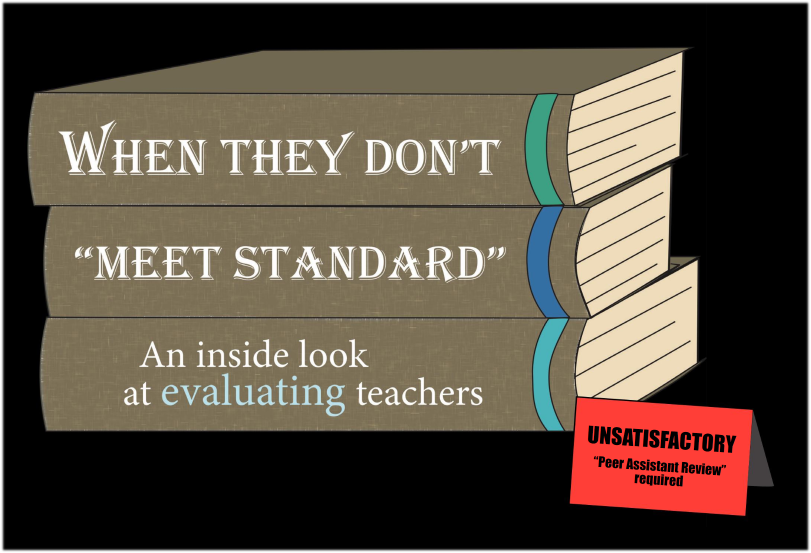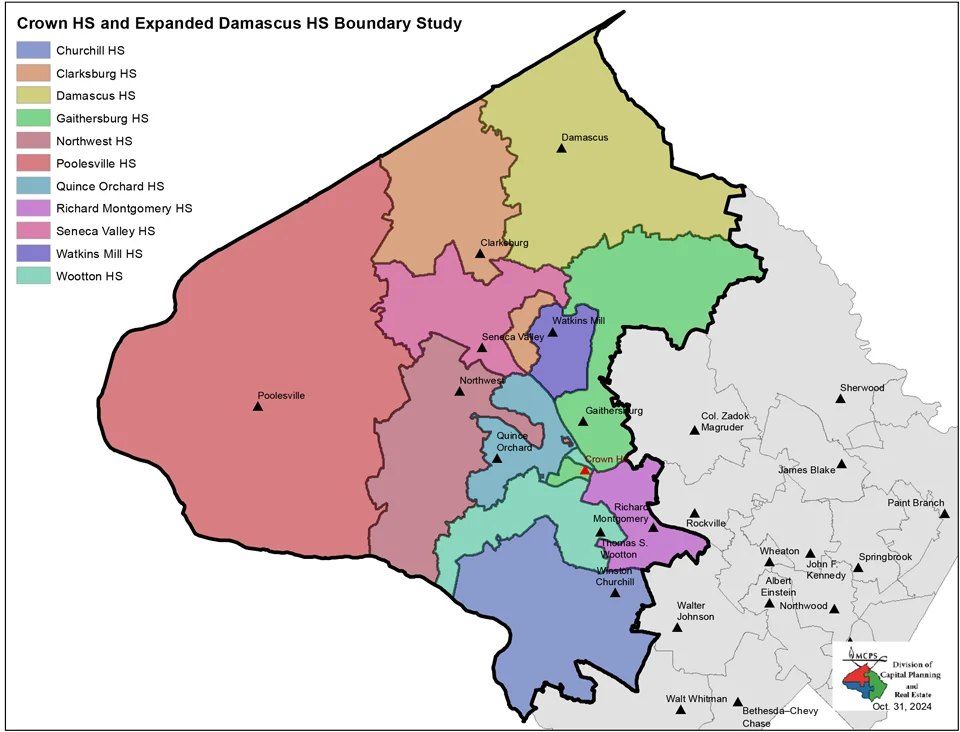When they don’t “meet standard”: An inside look at evaluating teachers
December 6, 2022
Some names have been changed to respect students’ and teachers’ privacy.
Every student knows that one teacher, at Whitman or elsewhere. The teacher who made their older sibling cry. The teacher who’s constantly the subject of their friends’ complaints about unfair grading policies or ineffective instruction. The teacher who’s been at their school for years and has never changed their behavior, despite repeated complaints.
Public school teachers with or without tenure can be fired quickly, even immediately, when a proven offense is severe. However, students are stuck with ineffective or inappropriate teachers because of an otherwise red tape-filled firing process when it comes to any other kind of offense. The often extensive, high-cost series of evaluations, reports and recommendations protect innocent teachers from any personal discrimination from their superiors while simultaneously insulating insubordinate teachers who never do anything “bad” or “documentable enough” to be fired quickly.
Montgomery County is no exception. In the years between 2001 and 2012, Montgomery County Public Schools dismissed only 245 teachers who underwent the formal evaluation and review process: that includes tenured teachers every 3-5 years, but also every teacher new to the profession or new to MCPS. If distributed evenly among each MCPS school, that’s around one teacher fired for low-level offenses every decade.
The nationwide teacher shortage of 300,000 vacancies this fall, as reported in September by the National Education Association, also complicates the issue for school administrations, at least when it comes to underperforming teachers whose methods are ineffective but not abusive to their students.
One of the larger trade-offs with the way the evaluation process fits into high schools like Whitman is that it is confidential by design, creating the illusion that there is less accountability than there really is. But despite the confidentiality of the process, removal of teachers is very rare — even with fully developed systems in place.
In a formal evaluation the staff members in MCPS responsible for assessments, department heads or “resource teacher,” and the designated administrator from each department, grade teachers on six core teaching standards. These standards include measures such as ensuring that classrooms are effective, professional and welcoming. In order to “meet standard,” teachers must demonstrate proficiency in all six categories during their evaluation.
Analyses on these standards occur twice a year for all MCPS teachers who are in their formal evaluation year. Formal evaluations for all teachers consists of shared lesson planning with a department head “resource teacher,” lesson observations and follow-up written report completed by both the resource teacher and the administrator overseeing the department in separate semesters. Evaluations occur on cycles of decreasing frequency depending on how long a teacher has worked at a school.
While these formal evaluations ultimately occur in cycles, informal observations and conferences with teachers also take place in response to issues like a lack of professionalism, unfair grading practices, tardiness or repeated complaints from students. These complaints are often directed towards counselors or department resource teachers, who follow up as they see fit.
One of the main stakeholders in the teacher review and removal process within MCPS is the Montgomery County Education Association (MCEA) — the teachers’ union in MCPS. Like any other teachers’ union, MCEA exists to negotiate teachers’ working conditions, benefits, job security and to assist in any legal representation pertaining to the workplace.
MCEA President Jennifer Martin deeply believes in the union’s power to not only benefit teachers and their lives, but to improve students’ educational experience, echoing the MCEA’s common refrain of “teachers’ working conditions are students’ learning conditions.”
The MCEA, along with school resource teachers and administrators, takes conflict between teachers and their students and colleagues in MCPS seriously, said Martin.
For that reason, in the late ‘90s, MCPS worked with MCEA to implement the Peer Assistance and Review (PAR) program — a one to two year process intended to provide assistance, resources and advisory to all new teachers, as well as tenured teachers who don’t “meet standard” in their evaluations.
MCPS teachers who have only taught within the county reach tenure when they begin their fourth year, while MCPS teachers who have received tenure in another Maryland public school system earn it at the start of their second year.
The PAR Panel, a 16-person committee made up of teachers and administrators — which can include resource teachers and MCEA representatives — has a significant influence over the cases of staff members who are on PAR. That role includes working closely with each case’s consulting teacher, a teacher assigned by the county to help improve the practices of a teacher under review. The panel serves as a check on a school administration’s power over the PAR process of their faculty members.
If a teacher is new or is “put on PAR” they receive a year of support before a combination of the PAR Panel and other county and school authorities decide on whether the teacher should join the regular evaluation cycle or continue to another year of PAR support. If a teacher comes to the end of the PAR program without making the changes to their behavior that allow them to meet the unfulfilled standards, MCPS will allow the teacher’s contract to expire. In combination with a teacher’s evaluations, the entire process can last two to three years, even four in very rare cases. The length and complexity of the process are in its design, and also perpetuated by the funds and personnel that PAR demands.
History department resource teacher Suzanne Johnson plays a key role in the evaluation of teachers within her department. Conducting classroom observations, collecting evidence, writing detailed reports and submitting recommendations for teachers to be put on PAR occurs on a strict timeline and all of the responsibility falls on resource teachers and administrators, she said.
Since the union and the county are not directly involved in the standard stages of teacher evaluations at all, MCPS and the MCEA rely heavily on principals and administrators to effectively administer the PAR program.
“If a principal is doing their job,” Martin said, “they should be aware of who isn’t meeting standard in their building, and be giving those people extra support and extra attention to make sure that they’re improving.”
Improving a struggling or problematic teacher’s conduct through PAR takes a lengthy amount of time, during which students and coworkers may continue to be subjected to the behavior or deficiency under investigation.
“[It’s] not fair to the administrators, fellow teachers and parents,” said an anonymous MCPS teacher. “It’s definitely unfair to students that they’re getting a subpar education simply because some part of the system can’t remove this individual from their job.”
Sophomore Arjun Mohan believes that in education, if as a student you have a bad teacher, you’re not going to succeed, he said. At the end of the day, students bear the brunt of the damage caused by weaknesses in the system that holds teachers accountable, according to Mohan.
“When you have a teacher that doesn’t teach you, or treats you inappropriately, or somehow makes it a lot harder to learn, it gets really frustrating as a student,” Mohan said. “When the quality of the education is rather poor, but the level of learning you’re expected to demonstrate is really high, it ends up going poorly for everyone involved.”
The process leading up to and the PAR process itself are confidential by design, but the negative impact of this is students don’t always find their complaints are seen as legitimate and reach the teachers they need to see improve.
Not all tenured teachers enter PAR for the same reasons — there are a variety of reasons why a teacher may not meet standard. When teachers’ salaries, benefits and treatment in the workplace don’t allow them to properly attend to their home lives, they struggle to perform as teachers, and that harms the education experience for students, Martin said.
“I think we’re at that situation where we have to ask, does the teacher have the resources to be able to take care of their work-life balance?” Martin said. “That’s what makes a teacher truly able to focus on being an educator, and unfortunately, we don’t necessarily have those kinds of resources in place.”
Junior Claire believes that the overall learning experience of students deteriorates when teachers don’t seem to have enough time for them. When a teacher is too busy or too stressed to complete an important task for their job, the students suffer for it. She has first-hand experience with this, she said.
“When I tried to get my teacher to help me with my grade, she just got really frustrated and started complaining about her life and going on, how she didn’t have time for me,” Claire said. “I told her about concerns I had about a grade after the end of the quarter and she just got really mad at me and said, ‘I have too much going on at home. I can’t deal with this right now.’”
English department resource teacher Linda Leslie encourages every student whose school experience is negatively impacted by a teacher’s practices to communicate that to staff, she said.
“Even an anonymous note to your teachers is super helpful to say, ‘Hey, I can’t learn from this practice’ or ‘Could you make more structure in your lessons’ or ‘Could you post your notes?’” Leslie said. “There isn’t a teacher in the world who doesn’t reflect on issues brought to their attention by their students.”
Closing the divide between teachers’ poor behavior and the systems in place to respond to those issues can help protect students and school employees from teachers with problematic behaviors.
“The system itself is designed to make sure that we don’t have a situation where we have weak teaching anywhere,” Martin said. “But are we giving our administrators the time to do what they need to do? Are we providing adequate support through the consultant teacher cohort? That, we could be doing better.”










